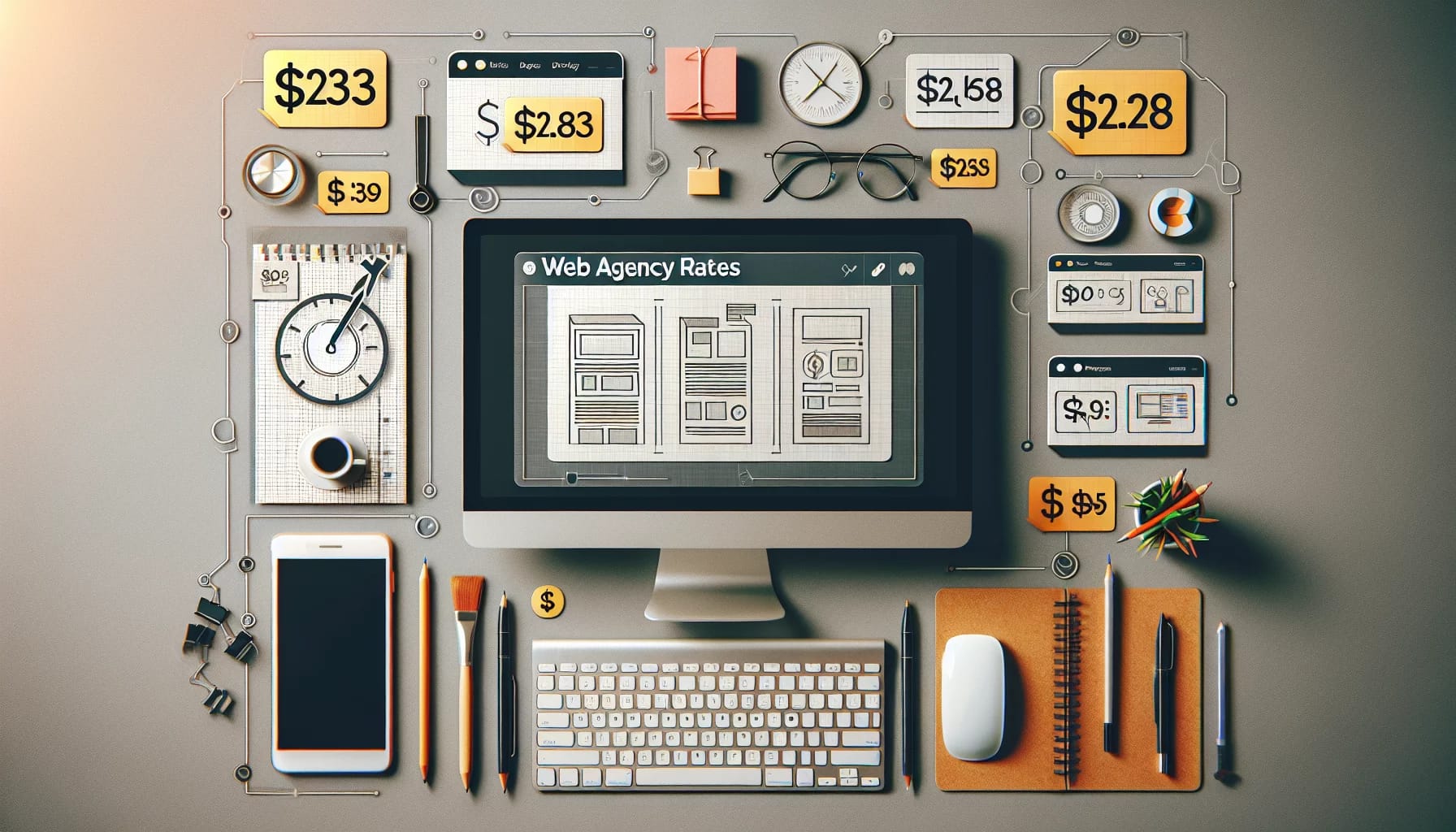Les Tendances Actuelles du Design Web
Le design web évolue constamment pour répondre aux besoins des utilisateurs et des entreprises. Voici un aperçu des tendances actuelles en matière de conception visuelle et d’interaction.
Tendances en Conception Visuelle
En 2024, plusieurs tendances de design se démarquent dans le domaine de la conception web. Parmi celles-ci, on trouve :
- Mode Sombre : De plus en plus de sites optent pour des thèmes sombres, qui offrent un contraste visuel attractif et réduisent la fatigue oculaire.
- Sites Monochromatiques : Une palette de couleurs réduit mise sur une seule couleur avec différentes nuances, créant une esthétique cohérente et élégante.
- Minimalisme Moderne : Un design épuré qui élimine le superflu pour une présentation claire et axée sur l’utilisateur.
- Narration Interactive : L’intégration de récits dynamiques dans la conception permet une interaction avec l’utilisateur et rend l’expérience plus engageante.
- Design Neumorphique : Un style qui joue sur les ombres et les reliefs pour créer des éléments d’interface qui semblent “pousser” hors de la page.
Ces tendances sont essentielles pour captiver l’attention des visiteurs et établir une première impression positive, car 94 % des personnes se basent sur le design pour juger une entreprise.
| Tendance | Description |
|---|---|
| Mode Sombre | Réduit la fatigue oculaire et offre un contraste attrayant. |
| Monochromatique | Utilise différentes nuances d’une seule couleur pour une esthétique cohérente. |
| Minimalisme | Suppression du superflu pour un design épuré. |
| Narration Interactive | Engage les utilisateurs à travers des récits dynamiques. |
| Neumorphisme | Utilise ombres et reliefs pour des éléments d’interface attractifs. |
Design d’Interaction et Animation
Le design d’interaction et l’animation jouent un rôle crucial dans la création d’une expérience utilisateur engageante. Les utilisateurs d’aujourd’hui s’attendent à une interface fluide et réactive.
Les éléments d’animation, tels que les transitions entre les pages et les micro-interactions (petites animations lors d’une action de l’utilisateur), améliorent non seulement l’esthétique mais aussi la fonctionnalité du site.
Un design restaurant l’attention sur l’accessibilité est essentiel. Cela inclut l’adoption de recommandations comme des descriptions alternatives pour les images et des options de navigation au clavier, garantissant ainsi qu’un large éventail d’utilisateurs, y compris ceux ayant des handicaps, puisse naviguer efficacement sur votre site.
Les tendances en design d’interaction, combinées avec des principes de SEO, garantissent que votre site n’est pas seulement attractif, mais aussi optimisé pour un bon classement dans les moteurs de recherche. Voici quelques éléments à considérer :
| Élément | Importance |
|---|---|
| Navigation | Facilite la recherche d’informations sur le site. |
| Lisibilité | Aide à capter et conserver l’attention des utilisateurs. |
| Quality Contenu | Contenu pertinent favorise l’engagement et le temps de visite. |
| Images & Structure | Indispensables pour une présentation visuelle et structurée. |
En adoptant ces tendances, vous pouvez transformer votre site en un outil efficace d’acquisition de clients. Pour en savoir plus sur les services d’une agence web, n’hésitez pas à explorer notre site.
L’Expérience Utilisateur (UX) dans le Design Web
Importance de l’UX
L’expérience utilisateur (UX) est cruciale dans le design web, car elle définit la façon dont une personne se sent lorsqu’elle utilise un produit, un système ou un service. Une bonne UX favorise la satisfaction et la fidélité des clients, tandis qu’une mauvaise UX peut inciter les utilisateurs à quitter votre site (SMA Marketing).
L’optimisation de l’UX contribue également à l’amélioration du référencement naturel (SEO) de votre site web, ce qui est essentiel pour augmenter la visibilité en ligne et attirer davantage de visiteurs. Voici quelques raisons pour lesquelles l’UX est indispensable :
| Raisons | Détails |
|---|---|
| Satisfaction Client | Une expérience agréable incite les clients à revenir. |
| Recommandations | Un bon site est davantage recommandé. |
| Conversion | Une UX efficace augmente le taux de conversion. |
Optimisation de l’UX pour la Conversion
Pour maximiser les conversions, vous devez optimiser l’UX en tenant compte des besoins des utilisateurs. Cela implique l’utilisation d’outils et de techniques variés pour améliorer l’expérience. Par exemple, la recherche utilisateur, les tests d’utilisabilité et les tests A/B peuvent fournir des informations précieuses sur le comportement des visiteurs et sur ce qui fonctionne le mieux sur votre site.
Voici quelques techniques pour améliorer l’UX en vue de convertir :
| Technique | Description |
|---|---|
| Recherche Utilisateur | Comprendre le public cible et ses besoins. |
| Test d’Usabilité | Évaluer la facilité d’utilisation du site par de vrais utilisateurs. |
| Évaluation Heuristique | Analyse des problèmes d’expérience en utilisant des critères d’expertise. |
De plus, il est nécessaire d’assurer que votre site est réactif. En effet, 57 % des consommateurs sont peu susceptibles de recommander une entreprise disposant d’un site mobile mal conçu (HubSpot).
Pour découvrir comment transformer davantage votre présence en ligne, explorez nos autres articles sur les services de l’agence web ou consultez nos options en référencement et en e-commerce.
Facteurs Clés pour un Site Web Performant
Impact du Design sur la Perception
Le design d’un site web joue un rôle crucial dans la perception qu’ont les utilisateurs de votre entreprise. Un site bien conçu inspire confiance et crédibilité, ce qui est essentiel pour convertir les visiteurs en clients. Un design attrayant attire l’attention et peut même influencer la décision d’achat.
Les éléments clés d’un bon design incluent :
- La simplicité : Un design épuré facilite la navigation et permet aux utilisateurs de trouver rapidement les informations qu’ils recherchent.
- L’esthétique : L’utilisation de couleurs harmonieuses et d’images de qualité peut améliorer l’expérience utilisateur et renforcer l’identité de votre marque.
- La réactivité : Environ 54 % du trafic web provient de téléphones mobiles, rendant important un design responsive qui s’affiche correctement sur tous les appareils.
| Élément | Importance |
|---|---|
| Simplicité | Facilite la navigation |
| Esthétique | Renforce l’identité de la marque |
| Réactivité | Augmente le trafic mobile |
SEO et Conception Web
L’optimisation pour les moteurs de recherche (SEO) et la conception web vont de pair. Un site bien conçu améliore non seulement l’expérience utilisateur, mais aide également les moteurs de recherche à comprendre le contenu du site, ce qui peut augmenter votre classement dans les résultats de recherche.
Principaux aspects du SEO à considérer :
- Indexation mobile : Google utilise l’indexation mobile-first pour classer les sites. Cela signifie que la version mobile du site est prioritaire dans l’indexation et le classement, rendant un design responsive essentiel pour un bon référencement.
- Architecture de l’information : Une bonne structure d’information (IA) facilite la compréhension de la hiérarchie du site par les moteurs de recherche. Assurez-vous d’avoir une navigation conviviale et des catégories claires.
- Techniques on-page : Cela inclut l’optimisation des titres, des balises et des descriptions. Une bonne utilisation des mots-clés renforce aussi le SEO général de votre site.
Pour garantir le succès de votre site en matière de SEO et de design, il est essentiel d’adopter une approche stratégique qui intègre à la fois des techniques techniques et sur page, tout en tenant compte des préférences des clients (Big Sea). Pour plus d’informations sur les services d’une agence web, consultez notre section dédiée sur services agence web et agence web référencement.
Choisir une Agence Web
Lorsque vous envisagez d’améliorer votre présence numérique, le choix d’une agence web design est crucial. Il est important de comprendre les services qu’une agence peut offrir ainsi que les critères à considérer lors de votre sélection.
Services et Fonctionnalités
Les agences web offrent une gamme de services adaptés aux besoins des entreprises, qu’il s’agisse de la création d’un site web ou de son optimisation. Voici quelques services clés que vous devriez rechercher :
| Services | Description |
|---|---|
| Conception de Site Web | Création de sites adaptés à votre marque avec un design réactif. |
| Développement E-Commerce | Solutions pour les commerces en ligne, intégrant des systèmes de paiement sécurisés. |
| Optimisation de Référencement (SEO) | Amélioration de la visibilité sur les moteurs de recherche pour augmenter le trafic. |
| Stratégies de Marketing Digital | Campagnes ciblées pour attirer et convertir vos clients. |
| Maintenance de Site Web | Support continu pour assurer le bon fonctionnement de votre site. |
Pour plus d’informations sur les services offerts, consultez notre article sur les services agence web.
Critères de Sélection d’une Agence
Lorsque vous choisissez une agence, plusieurs critères doivent être pris en compte pour garantir que celle-ci corresponde à vos besoins spécifiques :
-
Expérience et Réputation : Vérifiez le portfolio de l’agence, ses projets précédents, et les témoignages de clients.
-
Expertise en UX : Une bonne agence doit être capable d’améliorer l’expérience utilisateur grâce à des techniques comme le testing A/B, la recherche utilisateur, ou l’évaluation heuristique.
-
Compétences en SEO : Assurez-vous que l’agence a une connaissance approfondie des meilleures pratiques en matière de SEO, y compris l’optimisation du code, de la structure du site et du contenu (WebFX).
-
Approche de Design Réactif : Vérifiez si l’agence utilise des techniques de conception web réactive (RWD) pour s’assurer que votre site est accessible sur tous les appareils (Coursera).
-
Adaptabilité Multilingue : Si votre entreprise opère dans un environnement multilingue, recherchez une agence capable de fournir des services dans plusieurs langues.
Avant de prendre une décision, il peut être bénéfique de demander des devis et de comparer les tarifs agence web pour s’assurer d’obtenir un bon rapport qualité-prix.




